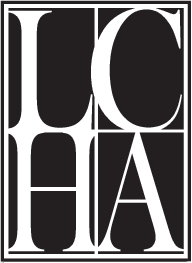Tape Looms “Just arrived, and to be Sold Cheap, a Choice variety of Haberdashery, …Laces, Cadisis (type of woolen tape), Quality’s Tapes, Pins, Needles, Shirt-button, Crewels in Shades.” Boston News-Letter, Apr 15/22, 1736 Tape looms are used to weave narrow, sturdy tapes. Usually not more than an inch wide, and they were woven narrower, tapes were colorful and were an …
A Dive into LCHA: Highlights from the Organization
When the Angels Descended on LCHA Each year the Costume Society of America (CSA) gives a small, deserving museum an opportunity to be the recipient of their “Angel Project” award. In 2017, such an opportunity presented itself to LCHA. The CSA’s National Symposium was held in Portland, Maine. The Angel Project is a one-day event, held each year near the …
A Dive into LCHA: Highlights from the Organization
Crewel Worked Bed Valances The bed hanging valences shown above are truly lovely in that the colors of the yarns have remained so vibrant. Dated to the 18th Century, they are very nice examples of American crewel work. The needle workers, as men and women both practiced the art, in the American Colonies developed a crewel work style of their …
A Dive into LCHA: Highlights from the Organization
LCHA’s Native American Collection Three years ago, the Pownalborough Court House stewardship committee oversaw a small installation in the third floor Jury Room exhibition space devoted in part to the French and Indian War period. Included in this presentation was a small selection of Native American material including birch bark and splint baskets and containers, hewn stone implements, and clothing. …
Court House Collections and New Connections:
LCHA receives generous donations of historic items connected to Pownalborough Court House – from across the country. A wonderful story about special gifts to the LCHA collections from far and wide was recently highlighted in the Lincoln County News. Click here for the article describing how these items found their way home to Dresden.
Object of the Week: Highlighting the LCHA Collections
Sack-Back Windsor Armchair This style of Windsor chair was probably initially developed in Philadelphia during the second half of the 18th century but its popularity soon spread to the other British colonies in North America. Our example is a relatively simplified version but contains all the essential elements of this chair type. It has a characteristic shaped pine saddle seat …
Object of the Week: Highlighting the LCHA Collections
Baking in a Brick Oven A previous article discussed the placement of the oven in Colonial fireplaces. Among a cook’s skills was knowing how to judge the temperature of the oven and to use it to best advantage. To heat up a brick oven, a fire is built inside it. On the floor of the oven small kindling was arranged and …
Object of the Week: Highlighting the LCHA Collections
The Brick Oven If one thing is clear about life for women in rural America during the years leading up to the Industrial Revolution, it is that they were required to have management skills and no where were those skills more important than in the economy of food preservation and preparation. Their use of the brick oven, built into the …
Object of the Week: Highlighting the LCHA Collections
Warm Drinks During the colder months—or even during the warmer months on a cool morning or chilly evening—a warming drink, made in a nice bright tin utensil, rather than the usual black cast iron, was a fine thing! Until after the American Revolution it was illegal to have a rolling mill to produce the tin sheets needed to produce utensils, …
Object of the Week: Highlighting the LCHA Collections
Peas, Honey, Knife There is an old nursery rhyme that includes: “I eat my peas with honey, I’ve done it all my life, it may sound kind of funny, but it keeps them on my knife.” To the present day, that may seem a bit odd, but it wasn’t during the Colonial era, and right into the 19th Century in …

 Newsletter
Newsletter Join LCHA
Join LCHA Donate Now
Donate Now